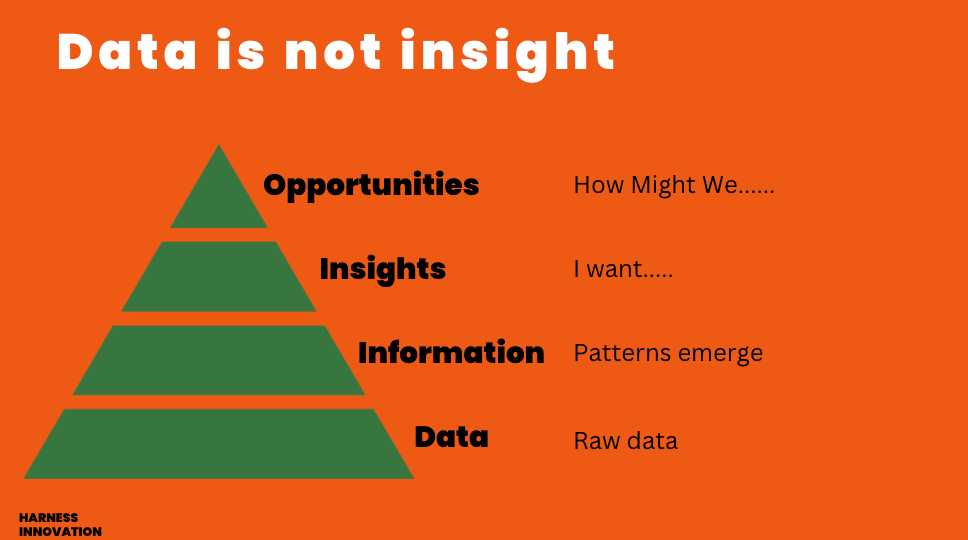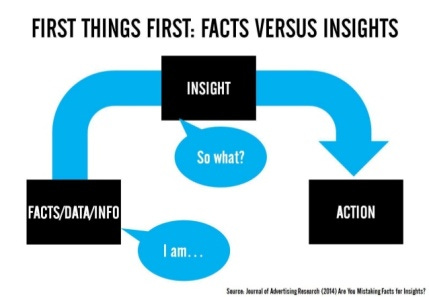Are you jumping from data to action?
...If so, you're missing out on the REAL opportunities
This image was inspired by Tom Kerwin’s excellent substack blog.
A big mistake i’ve seen when it comes to uncovering new opportunities and innovation projects is jumping straight from data to ideas. This is because data without context and knowledge of strategy leads to products/campaigns/services which no body wants.
Why?
Well often the same data and information can lead to a totally different set of assumptions and ideas depending on that persons’ background and knowledge.
When this is done WITHOUT talking directly to customers or supporters and without understanding the current strategy and context things really start to fall apart.
The problem is that organisations are generally very good at getting the raw data and turning this into information (being data-driven) but they are less good at turning information into actionable insight which then lead to real opportunities.
Not having a repeatable process to do this results in big opportunities not being realised.
……Ok so i’ve used a lot of words here like ‘data’, ‘knowledge’, ‘information and ‘insight’ which are often used interchangeably. So let me break down what I mean with an example.
Example: High Value Legacy Pledgers
A great example of this in the charity sector is High Value Legacy Pledgers.
A lot of charities have uncovered the interesting piece of information that the majority of legacy income comes from a minority of legacy donors BUT this is being interpreted as insight and therefore there are a ton of different views and opinions on what this opportunity is.
When this opportunity it’s talked about in the sector, it’s been difficult to define exactly what that opportunity is from a supporters’ point of view.
Why is this?
Because it hasn’t been shaped into an opportunity….yet. At the moment it is just information (all be it very intriguing information).
Let me explain.
There is a difference between Data, Information and Insight as illustrated in the graphic below:
See definitions with examples below:
Data = The raw data (using the High Value Pledgers example this is data points on a database)
Information = Facts provided on a particular subject e.g. 75% of legacy income last year came from 25% of legacy donors. Although this is intriguing, it is still just information, not an insight.
Insights = A truth hidden in plain sight which has potential to unlock growth. Generally expressed as ‘I want’ statements from the customer or supporters’ point of view.
Opportunities = Combine insight statements with knowledge and context, opportunities are defined in the form of How Might We questions and used to generate ideas. Please note i’ve called these opportunities NOT ideas. This is because ideas are cheap and opportunities based on market value, internal context and customer needs should be prioritised first before idea generation. E.g. How might we make it easier for Legacy Pledgers to have tough conversations with their family by making it stress free, easy and enable them to take action?
But how do you go about moving from facts to opportunities?
Lay out the cold, hard facts
Where are the key facts we know now? Do any contradict each other?
What are the key questions you need to answer?
This normally leads you to qualitative questions i.e. the why behind the facts you’ve established
Create a research brief and scope
Decide who you need to talk to and create a discussion guide with questions to answer
Conduct the research
Talk to customers in your defined target audience
Synthesise the data
Make sense of the qualitative data
Write up insight statements
Bring to life and share with key stakeholders
Generate opportunity springboards
Combine with knowledge and context generated by your opportunity work. Generate opportunity statements
Score your opportunity springboards
You do this through the Harness Innovation Scorecard which Desirability, Feasibility and Viability and narrows down your opportunities to focus on before generating ideas.
Free Call
Jump on a free call if you’re interested in hearing more about how this works in practice and what an opportunity statement flash card or scorecard looks like. A heads up i’m fairly busy at the moment but drop me a message and i’ll see what I can move around to meet if necessary.
High Value Legacies Catalyst Programme 🚀
There are still a few spots left for my High Value Legacies Catalyst Programme which is taking place in September. This programme will uncover insight on this High Value Legacies audience and define clear opportunities and ideas for you to pursue.
So if you are a Legacy or Innovation Manager in the charity sector check it out and DM me on LinkedIn if you’d like more information. Macmillan, Dementia UK, Mind and Prostate Cancer UK have already signed up.



